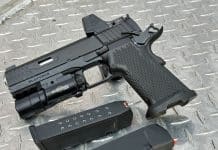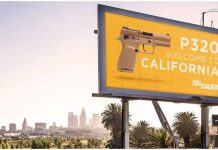What is the BEST configuration for an AR15 Police Patrol Rifle? Fred Mastison of Force Options Tactical Training Solutions shares his Top 10 points for rifle selection.
On February 28th, 1997 a LAPD unit call for assistance with a “211 in progress” (armed robbery) and subsequent “Shots Fired – Require Backup” would forever change the law enforcement weapons culture. This was of course the infamous North Hollywood shoot out where the LAPD ended up engaging two heavily armed suspects determined to avoid capture after a bank robbery. The two assailants were armed with fully automatic rifles while the responding officers were relegated to a variety of handguns and the rare shotgun. The two suspects were not only heavily armed, but they also utilized body armor which the police stood little chance of defeating with handguns. This situation eventually drove several officers to enter a local gun store where they secured rifles to engage the suspects. The fight continued until SWAT arrived and the suspects were stopped.
In the end there were over 2000 rounds fired by both sides and when the smoke cleared there were 18 casualties and two fatalities. This was one of the longest and bloodiest shoot outs in American law enforcement history.
The incident sent ripples through the law enforcement community around the country. It became evident that a glaring hole in firepower existed in the standard officer’s load out. Debate began and the voices of officers began to be heard. They needed rifles. While there have always been agencies that deployed rifles with their standard patrol officers, a vast majority of agencies issued handguns and the occasional shotgun as their general weapons package. The detailed review of the events in North Hollywood however became the catalyst for agencies across the US to review their policies regarding rifles.
At first many agencies scrambled to get rifles into patrol divisions. It was a mixed bag of weaponry ranging from Ruger mini 14’s to M1 carbines. The rifle that ultimately would take center stage however was the AR15. Taking its’ cue from the military, most agencies began to adopt the AR15 as their primary duty rifle. It is light, easy to shoot and was relatively inexpensive to equip an agency with. Additionally, many officers across the country had prior military service and were already familiar with the AR15 platform. This allowed for a fairly smooth integration of the rifle into service. The evolution of the patrol rifle here in the United States was partly influenced by law enforcement agencies around the world. Progressive US agencies did their homework and looked at what their professional brothers and sisters were carrying abroad. What they found was a variety of weapons that ultimately were well thought out and appropriate for their jurisdiction. From the H&K MP5 carried by some members of the London Metropolitan Police force to the Beretta AR70/90 carried by the Italian Carabinieri. What was ultimately concluded was that whatever rifle they chose, it had to serve in a specific role; a role that had the potential for diversity that would challenge most weapon systems. This only solidified the place of the AR15.

Jump forward 16 years and we now see the current state of the rifle in law enforcement culture. It is set in stone and you would be hard pressed to get most officers to give up the comfort that a carbine brings. What is not as set in stone is the configuration and brand of rifles in service. When I teach a law enforcement carbine classes I am prepared to see an incredible variety of rifles and set ups. From old Bushmasters with fixed carry handles to Noveskes fitted with enough hardware to land the space shuttle; I see it all. One of the reasons for this variety is that many agencies across the country allow officers to purchase their own weapons and use them on duty. They submit their request and most agencies compare it to an “approved rifle” list. While this is financially beneficial to the agency, it creates a mixed bag of hardware. Add to that the inevitable “customization” of rifles which is more a rite of passage than an option. This creates a potentially problematic diversity of rifles inside an agency. The biggest problem this creates is in “cross use”. Cross use is when another officer may need to deploy your weapon. They need to be as familiar with it as they are with their own. The willingness of agencies to allow such a wide spectrum of guns and modifications has the potential to come back and bite them at some point.
So what is the BEST configuration for an AR15 Police Patrol Rifle? This is an age old question that I have been getting for years. My response is pretty straight forward and is based on seeing thousands of rifles come though my classes. As with many things in the firearms world, there are different opinions but this is what I preach. Here is my primary 10 points for rifle selection.
- Choose a solid manufacturer. The old adage of you get what you pay for is absolutely true. If the gun only costs $500.00, there is a reason for that.
- Unless you have a mission specific reason, go with a 16” barrel. This provides the best balance between muzzle velocity, accuracy and size.
- Choose a rifle chambered for both 5.56 and .223 (yes, there is a difference). This will make the weapon flexible to work with different ammunition the department is purchasing at that time.
- Choose a collapsible stock. This allows the gun to be better fit to the individual operator. Note: Store the rifle with the stock in the position you need it. If you are forced to pull a rifle out, you do not want to be wasting time getting your stock set up.
- Choose a flat top optic ready rifle. This makes it much simpler to install optics. See point number 6.
- Mount professional quality optics on the rifle. I suggest red dot sights that allow the user to shoot with both eyes open.
- Install back up iron sights. In the event an optic goes down, the fight must continue.
- Install a good sling. If the deployment of the rifle goes on or if you need to have your hands free, a sling will be a priceless addition.
- Attached a white light. I encourage a light that has a temporary on/off function as well as an “On” switch.
- Use Pmags or other reliable polymer magazine. Metal magazines are prone to failure.

There are obviously more detailed points that are discussed regarding rifle choice such as triggers and special bolt carrier groups. These topics however are not generally applicable to law enforcement rifles. There are only so many modifications that an agency can do to a rifle before they start dancing around the liability issue. Unless you have a very progressive agency, you will be required to keep the internals of the rifle as stock. Maintained and oiled, these weapons will serve agencies well for years.
It has been said that a handgun is nothing more than a weapon to help you fight your way to a rifle. That phrase has some merit. The world is a dangerous place and those who choose to wear a badge step into that danger on a daily basis. The addition of patrol rifles to an officers’ available equipment is nothing but a positive in my mind. Our hope is that it is never deployed, but if a North Hollywood event should happen again, I know that agencies across the US and around the world are better prepared to engage and stop the threat.
About the Author
Fred Mastison is the owner and senior instructor of Force Options Tactical Training Solutions. Mr. Mastison has been actively training law enforcement, military and civilians for over 25 years. He holds over 16 different P.O.S.T course certifications around the country and is a regular instructor in Europe. He is a LE Certifying Instructor in handgun, patrol rifle, shotgun and sub machine gun. He can be found at www.ForceOptionsUSA.com













[…] Go to this article […]
Comments are closed.